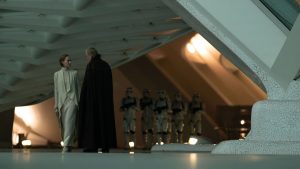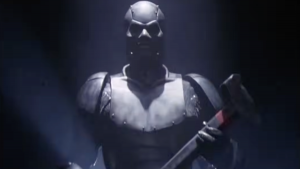
The Alien franchise has long fascinated me. Ever since watching and falling in love with the first claustrophically terrifying Alien at way too young an age, followed by the epic, action-packed Aliens, I have been hooked. I’ve seen every movie since (excluding the Alien vs Predator movies, which are not considered canon). As with any loyal fan, I’ve found things to love in every film following the first two (the campiness of Resurrections, for example) and to be disappointed by (I still haven’t gotten over the decision to kill Newt in Alien 3).
It’s within that vein, and with a robust rewatch of all previous films, that I approached Alien: Romulus, yet another entry in the series which takes place chronologically between Alien and Aliens. It’s not perfect, to be sure, but unlike a majority of the films after Aliens, it’s one made with more dedication behind it, and with a clear passion for the series itself. It’s a ride worth taking.
Back to the Basics
Alien: Romulus begins on a dark colony planet with no sunlight. Here, our central characters are miners, who are forced to work in order to gain the freedom to travel elsewhere. The characters include Rain Carradine (Cailee Spaeny) and her android brother Andy (David Jonsson), as well as another group of people led by Tyler (Archie Reneaux), Tyler’s sister Kay (Isabela Merced), their cousin Bjorn (Spike Fearn), and Bjorn’s girlfriend Navarro (Aileen Wu). Tyler convinces Rain and Andy to join them on a renegade mission to intercept an abandoned spaceship passing overhead, which has cryosleep pods on it that they could then use to make it to another planet. After gaining access to the ship, things don’t go so smoothly, as what happened to this ship and all its crew members is slowly revealed.
From its outset, Alien: Romulus does seem to resemble previous films in the series. An unlikely crew decides to investigate a mysteriously abandoned ship or location, only to discover what horrors had happened to the people there. Here, they may be younger and more inexperienced then, for example, the marines in Aliens, but the initial idea is familiar. The claustrophobic location also harkens back to Alien, with much of the action taking place within the ship itself.
source: 20th Century Studios
Character-wise, our central crew is also quite familiar. You have the expendable character, the headstrong one, the vulnerable one, an android who may have more up his sleeve than initially seen (Jonsson is magnificent as Andy, playing an almost dual role), and of course, you also have a Ripley-like protagonist in the form of Rain, played by the young, emotive Spaeny. Of all the Ripley-ish characters in previous films, she may shine as the strongest, holding her own against the fierce Xenomorph creatures as well as the characters surrounding her.
Director Fede Álvarez leans into these similarities throughout, giving us Alien fans a healthy dose of nostalgia wherever possible. A controversial familiar character may be the most obvious Easter egg, which I won’t spoil for those who haven’t seen, but in the context of the film having this character does make narrative sense, even if the digital effects aren’t quite there. Keep an eye out for additional references, of which there are plenty, with at least one coming from every movie in the franchise. There was one line that made me shake my head a bit (you’ll know when it comes), but it’s still a playful nod to one of this franchise’s most iconic moments.
Real Sets and Practical Effects
Alien: Romulus is unique in modern films due to Álvarez‘s reluctance in using green screens or CGI, similar to the 1970s and 80s when Alien and Aliens came out and these aspects were not as commonly used. Instead, more time was spent on creating lavish film sets, and practical effects were primarily used for the aliens themselves, featuring actors in suits or the use of props. Absent are the CGI aliens from Alien: Covenant and overuse of green screens from both that film and Prometheus; the result is a film that feels much more real and genuine. The fear is more palpable when we really feel as if giant hulking creatures with double mucus-dripping mouths and spiny tails are encrouching on our characters.
source: 20th Century Studios
The production design of Romulus also has a very retrofuturistic feel to it, with basic computer technology used on the spaceships, in a way resembling the future as was seen in the 1970s. It’s yet another aspect that makes the film feel more in line with the original Alien series. after all, why does the technology in both Prometheus and Alien: Covenant seem stronger than the films which succeeded it chronologically? To me, the directorial choices in those films just didn’t make much narrative sense.
The Action
Putting together the elaborate production designs and the practical effects, and joining this with familiar musical themes (some elements from the scores of Alien, Aliens, and Prometheus can all be heard), and now all you have to do is establish an engaging story around this, with some adrenaline-pumping action and gruesome deaths. And here is where Alien: Romulus sometimes comes up short. The story itself, which feels shoehorned in to begin with, just doesn’t give the characters enough to do, with several narrative choices throughout feeling forced or predictable.
There are some excellent setpieces in the film to be sure, such as one where the characters are forced to tread quietly through a dark room full of eager facehuggers, and a sparsely lit fight in a Xenomorph nest a la Ripley’s final scene in Aliens, yet it does feel lacking at other moments. Spaeny does her best Ripley impression in these scenes, but unfortunately the film sometimes doesn’t give her enough to equal up to Sigourney Weaver‘s best moments. It also doesn’t help matters that the final monster she fights is just a tad too silly as opposed to being as scary as the designers intended. Essentially, there’s just enough there to keep you hooked to the action, but it also won’t blow you away; this takeaway does actually sum up Alien: Romulus as a whole.
Conclusion
To conclude, Alien: Romulus is a step in the right direction for this long-running series. It’s essentially Álvarez‘s ode to a franchise that many of us have grown to love, even if some of the movies following the first two have disappointed in various ways. Yet, this one feels fully within that same world, joining both the original Alien series and the Prometheus prequels.
Nostalgia aside, Álvarez also has a knack for elaborate production design in addition to building intense action sequences and engaging characters, even if some of his narrative choices sometimes feel amiss. Yet, for the first time since this series’ comeback in 2012 with Prometheus, I’m finally looking forward to another Alien film. Here’s to hoping the next one follows suit.
Alien: Romulus is now playing in theaters worldwide.
Does content like this matter to you?
Become a Member and support film journalism. Unlock access to all of Film Inquiry`s great articles. Join a community of like-minded readers who are passionate about cinema – get access to our private members Network, give back to independent filmmakers, and more.










